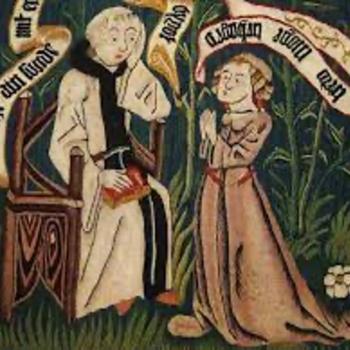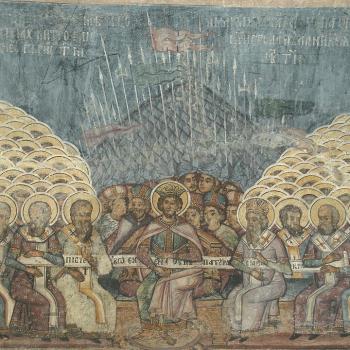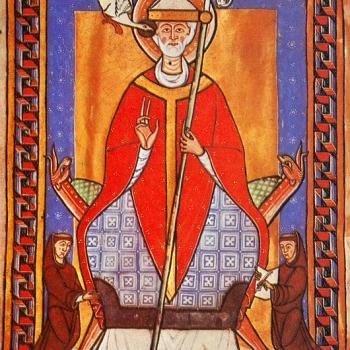I find artistic depictions of Christ to be fascinating, not only because they reveal truths about Christ, but because they reveal our own priorities, blind spots, and worldviews. Take Matthias Grünewald’s Isenheim Altarpiece, for example. In his depiction of the resurrection, Grünewald’s Christ springs forth triumphant from the tomb, while the soldiers run in fear. The light pouring from his face and wounds might be theologically edifying, while dwelling on Christ’s victory over death. But, conversely, it isn’t hard to notice that Christ is very white and very blonde, here. What does this tell us about Grünewald’s worldview, a German painter from the 15th and 16th century?
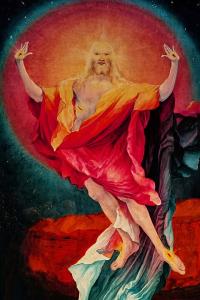
I might argue that any depiction of Christ in a sermon, painting, or other medium, necessarily calls for a translation of sorts. Christ and the Gospel, in a sense, transcend culture—but they are always discussed and expounded upon using the language and ideas from a culture. As the Gospel spread throughout the world, Christians historically have proclaimed Christ in ways that make him accessible and understandable. To me, one of the most fascinating and surprising examples of this is one that depicts Christ as a great Chieftain, a warrior and leader—the Heliand.
The Heliand
The Heliand—or Healer, in Old Saxon—is a Gospel paraphrase written as a verse poem sometime in the early 9th century. While the author is unknown, the epic comes in the wake of the forced conversion of the Saxon people by Charlemagne. This restructured and reimagined account of Christ birth, life, death, and resurrection is meant to evangelize and teach about this God whom the Saxon’s now worship. But, in the author’s attempts to make this story accessible, a unique fusion of Christianity and Germanic warrior society is born.
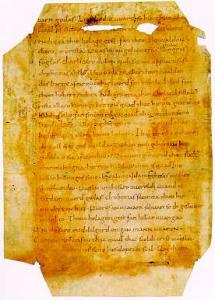
There are a lot of seemingly harmless ‘translations’ in this work, although there are perhaps some unseen implications. The cities in the canonical gospels, for instance, are often ‘saxonized’. Thus, Nazareth becomes Nazarethburg and Bethlehem is Bethlehemburg, which would be understood as a ‘hill fort’ in Saxony. Or, in another instance, the original recipients of the good news of Christmas are reimagined: “As horse servants they were outside, they were men on sentry duty, watching over the horses, the beasts of the field” (Heliand, Song 5, translated by G. Ronald Murphy). The shepherds are now ‘horse-servants’, a scene much more familiar to those in this community.
There are some translation efforts that might give us more pause for concern though. For instance, Simeon and Anna, upon encountering Christ in Jerusalem, are depicted as soothsayers: “The old man spoke secretly with the good woman at the altar in soothsaying told her how her Son would be the downfall of many of the sons of man the help of many others here in the middle world” (Heliand, Song 6). Or, when discussing the temple, the author uses the Germanic word ‘uuiha’, which clearly paralleled a “Germanic place of (pagan) worship to his hearers” (G. Ronald Murphy, The Heliand, xv). Even the disciples, while depicted as fisherman, are called warriors after Christ’s call to follow him. “He chose for Himself twelve good, loyal men to be the followers whom He, the Chieftain, wanted to have around Him every day from this day forward in His personal warrior-company” (Heliand, Song 15).
Perhaps most egregious of all is the use of magic. The creation of the world and the writing of the gospel are called ‘secret runes’, or word magic ordained by God (Song 1). The author records that the deceiver, that is Satan, uses a “magic helmet” to frighten Pilates wife (Song 65), and even speaks of the eucharist as magical. Most jarring is, perhaps, the introduction to the Lord’s Prayer: “Do this for Your own followers—teach us the secret runes” (Song 19). This implies that the repetition of the Lord’s prayer was as powerful as a spell or Germanic charm, when spoken with bowed head.
Critiquing or Confirming Culture?
But what of Christ himself? Unsurprisingly, Christ is depicted as a warrior Chieftain, the son of God—a confirmation of this culture’s ideals. Now, we might fear that this Christ is off slaying beasts or preaching violence. Yet, many of his teachings are consistent with the canonical gospels. The author records several of the beatitudes, for instance, as such:
“He said that those were fortunate here in this middle world who were poor in their hearts through humility, ‘to them is granted the eternal kingdom in all holiness, eternal life on the meadows of heaven.’ He said that those too were fortunate who were gentle people, ‘they will be allowed to possess the great earth, the same kingdom’… He said that those too were fortunate ‘who live peacefully among the people and do not want to start any fights or court cases by their own actions, they will be called the Chieftain’s sons for he will be gracious to them, they will long enjoy His kingdom” (Song 16).
Rather than the promotion of violence and the pursuit of glory, the Saxons are encouraged to be a humble, gentle, peaceable people through Christ’s teaching—a critique of warrior culture. But the author can’t completely escape this warrior Jesus mentality, at least in his discussion of the spiritual life. Christ, in this retelling, is led into the wilderness with Satan to enter into holy warfare. Christ “wanted to let powerful creatures test Him, even Satan, who is always spurring men on to sin and malicious deeds.” Conversely, Satan wanted to ruin God’s plan, so he set out to deceive Christ as he deceived Adam in Eden. But “the Ruler’s Child hardened His heart and stiffened His mind against the blasphemer—He wanted to win the heaven-kingdom for people” (Song 13). Rather than a demonstration of obedience to God’s plan of salvation, this story is now one in which Christ wins the kingdom in single handed combat against Satan.
Making Christ into our Image
It is easy to look back at a text like the Heliand with a bit of disbelief—how could anyone justify depicting Christ as a warrior Chieftain? And while there is much to critique here, my hope instead is to put the mirror back on ourselves. In some Christian circles, Jesus is seen as a John Wayne type (shout out to Kristin Kobes Du Mez’ Jesus and John Wayne), the epitome of masculinity—not unlike the Saxon Christ. This, of course, seems to contradict how Christ prioritizes the ‘least of these’ and calls for meekness. In other circles, Christ looks like a champion of personal autonomy and western liberties, an advocate for all forms of love. But does this wholly describe the man who overturned tables and called his followers to deny themselves and carry their cross? The list could go on and on—American Jesus, Black Jesus, communist Jesus, feminist Jesus, Dalit Jesus, etc.
I think there are better and worse ways to depict Christ amongst the options just listed, or rather, the canonical Jesus is more or less consistent with some of these depictions. But we must be mindful that we tend to make Christ in our own image, even while retaining many aspects of his teaching. The Heliand still discusses a call to be meek and peaceful, while framing Christ’s entire ministry as one of combat. Are we, like the author of the Heliand, depicting Christ in such a way that confirms our cultural norms? If so, we might be concerned that we are making Christ look like us. Do we have to stop depicting Christ, then? Certainly not—to proclaim Christ and his Gospel is to depict him in a certain way, hopefully one that is accessible to those around us. But in this process, we should be mindful of the deceit in our own hearts, the way in which our culture shapes us, and above all, “to be conformed to the image of his Son” (Romans 8:29), rather than the other way around.




